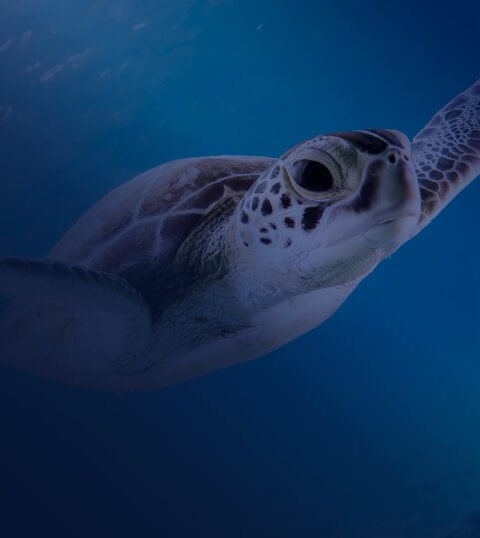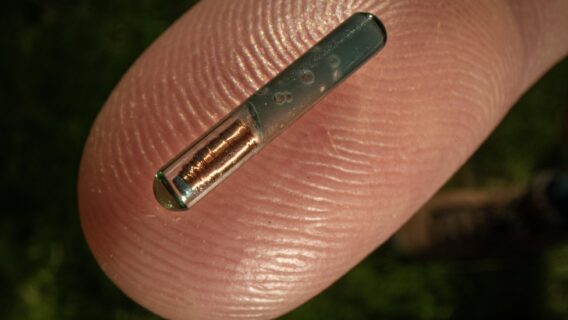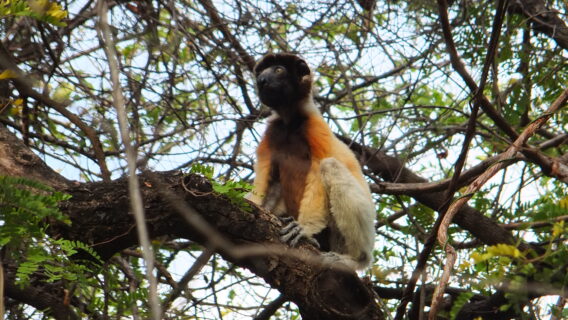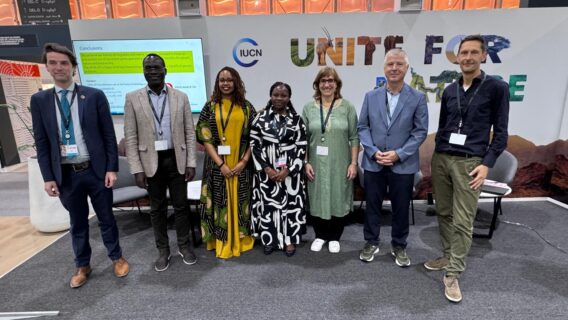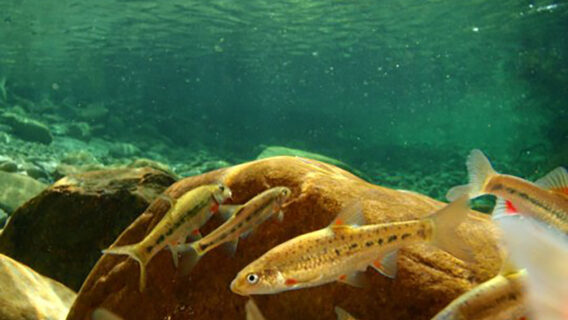2020: Our Year in Review
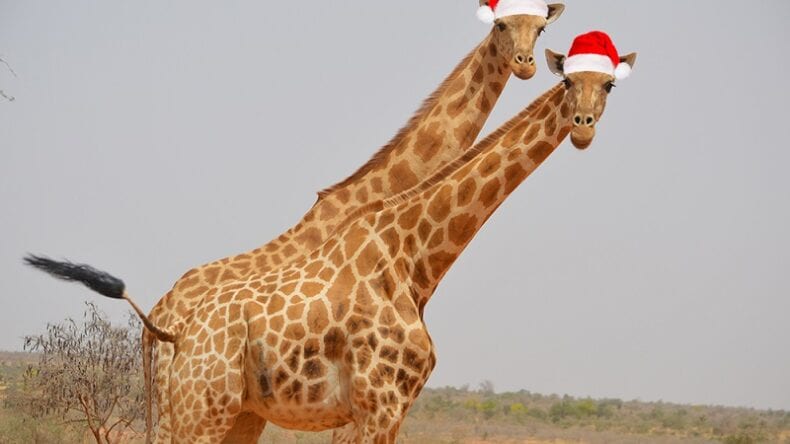
In spite of this, IUCN Save Our Species played a crucial role in responding to crises caused by the COVID-19 pandemic by disbursing emergency Rapid Action Grants. Through the hard work of our grantees, advice from IUCN’s many species experts and thanks to the support of our incredible donors and people like you, we were able to positively impact numerous species threatened with extinction while also helping local communities.
Below are just a few of the highlights:
Supporting increases in species populations.
One of our SOS African Wildlife initiative grantees has positively contributed to the increase of lion populations in Zambia. By doing extensive and thorough de-snaring work, they’ve been able to rescue and rehabilitate 44 snared lions, who have since contributed to the birth of 187 cubs, thus maintaining a thriving lion population.
Funding from the SOS Lemurs initiative has also made a positive contribution towards many lemur species, most notably to the survival of the Northern Sportive lemur.
As a result of [our] efforts, the population of habituated Mountain Gorillas increased by 8 individuals (151 to 159 individuals) between June and October 2020. This increase includes an extremely rare event: the birth of twins in the Mapuwa family. Sadly, one of the two twins did not survive.” Frédéric Henrard, Virunga Foundation, Congo
Frédéric Henrard, Virunga Foundation, Congo
Investing in protecting species.
As part of the SOS Gibbons initiative, more than CHF 460’000 are being invested over the course of the next three years in order to save four Critically Endangered and Endangered gibbon species. These projects will be implemented in Cambodia, Indonesia, Viet Nam and Lao PDR.
We are also proud to announce that this month, the third phase of the Integrated Tiger Habitat Conservation Programme (ITHCP) has officially begun. We are deeply grateful to the German Cooperation and KfW for their renewed support towards tiger conservation, which will allow funding another three to four large-scale projects in key Tiger Conservation Landscapes. With this, tiger conservation efforts will be pursued by IUCN and our grantees until at least the end of 2024, making ITHCP a ten-year programme! The first phase of the tiger programme, which was initiated in 2014 and consisted of 12 landscape projects, the largest of which is EUR 2.9 million, is currently ending. Projects of the second phase of the tiger programme are about to start in India, Bangladesh, Nepal and Myanmar after an initial design and preparation phase.
Thanks to our SOS grant, the status and existing threats to leopard populations in Tchabal Mbabo montane ecosystems in Cameroon have a glimpse of hope for survival.
Gordon Ajonina, Cameroon Wildlife Conservation Society, Cameroon
Responding to multiple conservation emergencies.
With funding from the European Union, IUCN Save Our Species unlocked emergency funding designed to enable immediate responses to threats linked to the pandemic. A total of EUR 4 million are being invested over the course of several months across Sub-Saharan Africa, South Africa and Madagascar.
Many of these Rapid Action Grants provide support to organisations and governments to maintain regular wildlife patrols and help local communities develop alternative source of income in light of drastically reduced tourism activities.
IUCN has enabled [us] to provide fast growing seedlings to 1002 vulnerable households addressing hunger brought about by drastically reduced income from tourism as a result of the COVID-19 pandemic, reducing their need to enter the gorillas’ habitat to poach.
Dr. Gladys Kalema-Zikusoka, Conservation Through Public Health, Uganda
Many children were coming to school without masks, [creating a] risk of spreading COVID and [they] were sent back home because they were not adhering to the Government law, however with this support [they’ve been enabled] to comply to with law and return to school to learn alongside their friends.
Mr. Nkhoma, head master of Milungu Primary School collaborating with Wildlife Action Group, Malawi
Despite the pandemic’s impact on the nascent tourism market in Chad, Zakouma has been able to ensure the continuity and development of its community projects.
Antoine Messager – African Parks Network, Tchad
Reducing poaching.
As one of the main threats to species populations, reducing poaching is one of the main objectives for many of our grantees. Many of the projects in our portfolio deal with this urgent issue, however, across a sample of 11 different SOS African Wildlife initiative projects, our grantees have been able to remove 1’928 snares, arrest 256 poachers and rescue 20 animals.
Reducing human-wildlife conflict.
Many threatened species share the same territories as local communities, which increases tensions between the two. A project in Namibia is aiming to reduce human-lion conflicts by helping farmers herd their cattle safely and moving lions out of populated areas. Another in Uganda deploys locally recruited community scouts to watch livestock and report any lion presence in the vicinity.
ITHCP’s biggest project (EUR 2.6 million going to ZSL and partners in various protected areas of Nepal and India) is now closed. It has however reported during this year an overall 70% decrease in human-tiger conflict incidents and a 50% decrease in the incidence of livestock death in project sites in Nepal, thanks to the measures put in place.
Protecting habitats.
Lemurs are threatened with extinction mainly due to deforestation. Unsustainable slash-and-burn agricultural practices are the main cause, and reversing this widespread activity is a priority for many of our SOS Lemurs initiative grantees in Madagascar. In 2020, 581’505 native trees have been planted within 17 different dry and humid forests across the country. 227’085 additional young seedlings are currently being prepared and will be planted over five different forests in 2021 to restore habitats and reconnect protected areas within the wider landscape. Furthermore, 22 projects across our SOS Central Asia and SOS African Wildlife initiatives work in 56 protected areas around the world.
On establishing two new wildlife conservation areas:
This is a really big move forward because it puts in place high level support and commitment towards saving these areas for snow leopards. […] Working closely with local communities and rangers will be the key to effective snow leopard conservation
Kubanych Jumabay, Snow Leopard Trust, Kyrgyzstan
[IUCN Save Our Species] funding has allowed for an invaluable enhancement of the protection and defence of biodiversity and the protected areas of Guinea at a particularly critical point-in-time, given the additional threats and challenges presented by the global COVID-19 crisis and the early stages of the Moyen Bafing National Park in its creation.
Dr. Shane M. Abeare, Wild Chimpanzee Foundation, Republic of Guinea
Working with local communities.
We can only save species if we collaborate. All of our grantees work closely with local communities as their help in protecting threatened species is essential. They involve them directly in conservation efforts by conducting awareness-raising workshops on threatened species and providing various forms of employment that put local communities in contact with wildlife. Additionally, they also provide them with alternative sources of income to combat the unsustainable use of the natural resources and decrease poaching. Across 15 different SOS African Wildlife initiative projects, our grantees have been able to reach out to over 59’000 people on the wildlife crisis and employ over 60 local community members. Over 23’000 people have benefitted from livelihood interventions.
Today’s workshop was very informative and definitely mind changing. I have learnt a lot about animal values, the importance of trees and the newly amended Forestry Act. These will all help me to do my job to protect the environment.
Wildlife Action Group workshop attendee, Malawi
Engaging young people in conservation.
Many of our grantees work closely with children and young adults in order to engage them as early as possible in conservation efforts. Grantees from our SOS Central Asia initiative reached out to 400 children across various environmental education programmes, as part of conservation action efforts for Vulnerable Snow leopard and Goitered gazelle populations. One of our SOS African Wildlife initiative grantees worked with over 6’000 children in a project that aims to decrease poaching activities in Malawi’s Thuma and Dedza Salima Escarpment Forest Reserves. It is worth noting that this year, the COVID-19 pandemic severely affected the participation of children in conservation efforts due to the closure of schools around the world.
Developing conservation guidance.
Thanks to support of IUCN Save Our Species, co-funded by the European Union, the IUCN SSC Antelope Specialist Group developed a series of recommendations for the Nigerien government on how to support conservation of Critically Endangered addax and dama gazelle populations. This is much needed guidance as only 30 to 90 mature addax individuals and 100 to 200 mature dama gazelle individuals are left in the wild.
Additionally, one our SOS African Wildlife initiative grantees in Zambia published a report on how human disturbance may affect the wide-ranging movements of the African wild dog in South Luangwa National Park.
The ITHCP thrives on the collaboration between their different grantees. Through shared experiences, they can learn from each other and maximise their impacts on the ground. This year, an extensive report (.docx) was published on how to improve human-wildlife conflict in tiger range countries.
Collaborating with children’s clothing brand Coq En Pâte to raise awareness of the plight of species close to extinction.
This summer Coq En Pâte launched its latest LOVE CATS collection, which familiarises children and their families with threatened lions, tigers, jaguars and cheetahs through colourful and fun clothing.
A huge thank you to everyone who supported species conservation in 2020. Thank you for your dedication and the messages of hope you share with the world and us every day. Together, we can make an even bigger difference in 2021.
Thank you also to our donors and partners, without whom the above achievements could not have happened.
Sending our warmest regards to you and your loved ones this holiday season,
The IUCN Save Our Species and ITHCP teams

